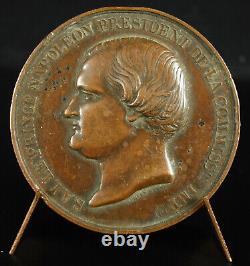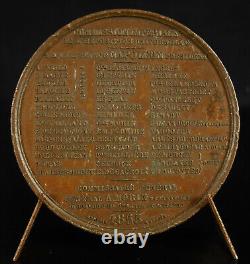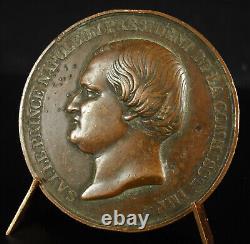Medal Le Prince Napoleon Commission Imperial of the Exhibition 1855 1 15/16in





215- TIR93 Copper medal from the Paris Mint (Handmarked from 1845 to 1860). Note on the reverse the names of: Mérimé, de Lesseps, Ingres etc....
Engraver : Barré, Gervais & co editor. Hallmark on the edge: hand + copper. The easel is not for sale. The stan d is not for sale. The Universal Exhibition of 1855 is an international fair-type event for commercial and cultural purposes which took place in Paris in 1855.
It is the first French universal exhibition (and the second worldwide, the first being the 1851 Universal Exhibition in London). It was held in Paris on the Champs-Élysées from May 15 to November 15, 18552. It welcomed more than 5,100,000 visitors.
Twenty-five states and their colonies participate3. It was by an imperial decree of Mars 8, 1853 that Napoleon III decided to hold a Universal Exhibition in Paris in 1855 where agricultural and industrial products would be exhibited, following the first Universal Exhibition of 18514. The same decree authorizes the admission to this Exhibition of products from all nations. The quinquennial Exhibition, which was to take place in 1854, was therefore postponed and combined with the Universal Exhibition. Another decree of June 22 in turn decides that a Universal Exhibition of Fine Arts will be held at the same time as the Universal Exhibition of Industry.
An Imperial Commission, with Prince Napoleon5 as president and Arlès-Dufour as secretary general, was formed on December 24, responsible for organizing these major events. This commission includes two sections: the Fine Arts section where we find the names of Prosper Mérimée, Eugène Delacroix and Ingres and the Agriculture and Industry section where we find the names of Charles Legentil, Frédéric Le Play, Ferdinand de Lesseps, Émile Pereire, Michel Chevalier6. The first task of the commission is to ask the prefects to organize a committee in each of the departments and to invite foreign governments to participate and appoint commissioners for the Exhibition. Plan and location of the Expo buildings The exhibition inauguration engraving Inauguration by Napoleon III of the Universal Exhibition in the Palais de l'Industrie (colored lithograph by Louis-Jules Arnout) The chosen location is the triangle formed by the Champs-Élysées, the Cours de la Reine and avenue Montaigne. The 1851 London Exhibition excited the competitive spirit and: The doors of the Crystal Palace had barely closed when from all sides people began to demand for Paris the honor of a similar competition7.» May 15, 1855 was the day of the official inauguration. Unfortunately the sun did not favor its solemnity. It was overshadowed, on the contrary, by rainy and cold weather, which the spring date could never have predicted8.
» The opening ceremony takes place in the Palais de l'Industrie in front of a large and international audience. Despite the Crimean War9 and the battles of the French navy in the Baltic, the Exhibition celebrates the economic collaboration of Nations. The palace of industry Detailed article: Palace of Industry. Engraving: The Palace of Industry Palais de l'Industrie next to the Champs-Élysées engraving: The Palace facing north North facade of the Palais de l'Industrie To host the Exhibition, a gigantic building10, the Palais de l'Industrie, was built along the Champs-Élysées.
Originally, the building was intended to house the National Exhibitions which had been held since the Revolution in poorly adapted premises. The design of the building is the result of the collaboration of architect Jean-Marie Victor Viel and engineers Alexis Barrault and Georges Bridel. The 208 meter long facade opened onto a monumental triumphal arch portal whose cornice is decorated with an allegorical group France crowning Art and Industry with gold, the work of the sculptor Élias Robert. This France is framed by groups of putti wearing arms. The 208 meter long facade opened onto a monume.

